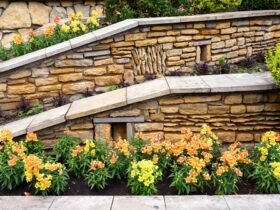Retaining walls are essential structures in landscaping that offer both functional and aesthetic benefits. They provide necessary support to prevent soil erosion and manage sloped terrains, while also adding visual appeal to outdoor spaces. This comprehensive guide explores various innovative retaining wall designs that can transform your landscape, including modern and contemporary styles, incorporating plants and greenery, creative lighting solutions, multi-tiered designs, and integrating retaining walls with outdoor living spaces.
Modern and Contemporary Retaining Wall Designs
Modern and contemporary retaining wall designs emphasize clean lines, simplicity, and the use of innovative materials. These designs often incorporate elements that complement contemporary architecture and landscaping trends.
1. Sleek Concrete Walls
Concrete retaining walls are a popular choice for modern landscapes due to their sleek appearance and durability. They can be designed with smooth finishes or textured surfaces to add visual interest. Concrete walls can also be tinted or stained to match the color scheme of your property.
2. Gabion Walls
Gabion walls consist of wire mesh cages filled with stones or other materials. They offer a rugged, industrial look that fits well with contemporary designs. Gabion walls are not only visually appealing but also highly durable and effective in controlling erosion.
3. Modular Block Walls
Modular block retaining walls use interlocking blocks that create a clean and uniform look. These blocks come in various sizes, shapes, and colors, allowing for customization to suit different design preferences. The modular system also makes installation relatively straightforward.
4. Steel Retaining Walls
Steel retaining walls provide a sleek and modern aesthetic. Often used in urban and industrial landscapes, steel walls are incredibly strong and can be fabricated in various designs and finishes. Over time, they develop a unique patina that adds character to the landscape.
5. Minimalist Timber Walls
Timber retaining walls, particularly those using hardwoods, can be designed with a minimalist approach. Simple, clean lines and natural wood finishes create a contemporary look that blends seamlessly with nature.
Incorporating Plants and Greenery into Retaining Walls
Incorporating plants and greenery into retaining wall designs not only enhances the visual appeal but also helps with soil stabilization and creating a more eco-friendly landscape.
1. Living Walls
Living walls, or green walls, integrate plants directly into the structure of the retaining wall. These walls can support various types of vegetation, including succulents, herbs, and flowering plants. Living walls provide a lush, vibrant appearance and improve air quality.
2. Tiered Planters
Designing retaining walls with built-in planters allows for tiered gardening. These planters can be filled with a variety of plants to create a cascading effect of greenery and flowers. This design is ideal for showcasing different plant species and adding depth to the landscape.
3. Climbing Plants
Encouraging climbing plants to grow on retaining walls can soften the hard edges and add a natural touch. Plants like ivy, climbing roses, and wisteria can cover the wall with foliage, creating a green tapestry that changes with the seasons.
4. Integrating Trees and Shrubs
Incorporating trees and shrubs around retaining walls provides a layered landscape design. Strategically placing these plants can enhance the structural appeal of the wall while providing shade, privacy, and additional soil stabilization.
5. Ground Cover Plants
Planting ground cover plants at the base of retaining walls helps prevent soil erosion and adds a lush green carpet. Plants like creeping thyme, sedum, and ajuga are excellent choices for ground cover that require minimal maintenance.
Creative Use of Lighting in Retaining Wall Design
Lighting plays a crucial role in highlighting retaining walls and enhancing the overall ambiance of the landscape. Creative lighting solutions can transform the appearance of your retaining walls, especially at night.
1. Uplighting
Uplighting involves placing lights at the base of the retaining wall to cast light upwards. This technique highlights the texture and structure of the wall, creating dramatic shadows and a sophisticated look.
2. Downlighting
Downlighting is the opposite of uplighting, where lights are installed at the top of the wall and directed downward. This method illuminates the wall’s surface and the area below, providing both functional and aesthetic lighting.
3. Recessed Lighting
Recessed lights are installed within the retaining wall itself, creating a sleek and modern appearance. These lights are ideal for illuminating pathways, steps, and other functional areas without being obtrusive.
4. String Lights
String lights add a whimsical and inviting touch to retaining walls. They can be draped along the top of the wall or integrated into the design to create a festive atmosphere, perfect for outdoor gatherings and entertainment.
5. Solar Lights
Solar lights are an eco-friendly and cost-effective option for lighting retaining walls. They harness solar energy during the day and automatically illuminate at night, providing soft and ambient lighting without increasing energy costs.
Multi-Tiered Retaining Walls for Complex Landscapes
Multi-tiered retaining walls are an excellent solution for managing complex landscapes with significant elevation changes. They create multiple levels of usable space and add depth and dimension to the landscape design.
1. Terraced Gardens
Terraced gardens use multi-tiered retaining walls to create a series of flat, usable spaces on a slope. Each level can be planted with different types of vegetation, creating a layered and visually appealing garden.
2. Cascading Water Features
Incorporating water features into multi-tiered retaining walls adds a dynamic and soothing element to the landscape. Water can cascade from one level to the next, creating a waterfall effect that enhances the aesthetic and auditory experience.
3. Integrated Seating Areas
Designing multi-tiered retaining walls with built-in seating areas provides functional outdoor spaces. These areas can be used for relaxation, socializing, or enjoying the view of the landscaped garden.
4. Staircases and Pathways
Incorporating staircases and pathways into multi-tiered retaining walls ensures easy access between different levels. These elements can be designed to match the style and materials of the retaining walls, creating a cohesive look.
5. Varied Materials and Textures
Using different materials and textures for each tier of the retaining wall can create a visually interesting and dynamic design. Combining stone, brick, timber, and concrete can highlight the different levels and add a unique character to the landscape.
Integrating Retaining Walls with Outdoor Living Spaces
Retaining walls can seamlessly blend with outdoor living spaces, enhancing both the functionality and aesthetics of your property. Here are some innovative ways to integrate retaining walls with outdoor living areas:
1. Outdoor Kitchens and Barbecues
Retaining walls can be designed to include built-in outdoor kitchens and barbecue areas. These functional spaces can be equipped with countertops, grills, and storage, creating an ideal setting for outdoor cooking and dining.
2. Fire Pits and Seating
Incorporating fire pits and built-in seating into retaining wall designs provides a cozy and inviting gathering space. Stone or brick retaining walls can be extended to create seating areas around a central fire pit, perfect for evening relaxation and entertainment.
3. Patio and Deck Integration
Retaining walls can define and support patio or deck areas, creating a seamless transition between different outdoor spaces. They can also provide additional seating, privacy, and structural support for elevated decks.
4. Water Features and Pools
Designing retaining walls to incorporate water features, such as fountains, ponds, or pools, adds a luxurious touch to outdoor living spaces. These elements can be integrated into the retaining wall structure to create a cohesive and elegant design.
5. Garden Rooms and Outdoor Offices
Retaining walls can be used to create enclosed garden rooms or outdoor offices, providing a private and tranquil space. These areas can be designed with large windows, doors, and integrated landscaping to blend seamlessly with the natural surroundings.
FAQs about Innovative Retaining Wall Designs
Modern and contemporary retaining wall designs offer a sleek, clean, and stylish appearance. They often use innovative materials and construction techniques, providing both aesthetic appeal and structural integrity.
You can incorporate plants into retaining wall designs by creating living walls, tiered planters, using climbing plants, integrating trees and shrubs, and planting ground cover at the base of the wall.
Effective lighting options for retaining walls include uplighting, downlighting, recessed lighting, string lights, and solar lights. Each type provides different aesthetic and functional benefits.
Multi-tiered retaining walls help manage significant elevation changes, create multiple levels of usable space, and add depth and dimension to the landscape. They are ideal for terraced gardens, water features, seating areas, and more.
Retaining walls can be integrated with outdoor living spaces by including built-in outdoor kitchens, fire pits and seating areas, patios and decks, water features and pools, and creating garden rooms or outdoor offices.
Common materials for modern retaining walls include concrete, gabions, modular blocks, steel, and timber. Each material offers unique benefits and can be chosen based on aesthetic preferences and functional requirements.
Yes, eco-friendly options for retaining wall designs include using sustainable materials, incorporating living walls or green walls, utilizing solar lighting, and designing walls to support natural water flow and soil stabilization.
Maintain a retaining wall with integrated plants by regularly watering, pruning, and fertilizing the plants. Ensure proper drainage to prevent water damage and monitor for any signs of structural issues caused by root growth.
Yes, retaining walls can be used in small outdoor spaces to create functional and visually appealing areas. They can provide support for raised garden beds, define seating areas, and add vertical interest to compact landscapes.
Creative lighting ideas for retaining walls include using color-changing LED lights, incorporating artistic light fixtures, creating patterns with recessed lights, and combining different lighting techniques to highlight architectural features.
Conclusion
By exploring these innovative retaining wall designs, you can enhance the beauty and functionality of your landscape. Whether you prefer a modern aesthetic, want to incorporate greenery, or integrate outdoor living spaces, these design ideas provide inspiration for creating a stunning and sustainable outdoor environment.










